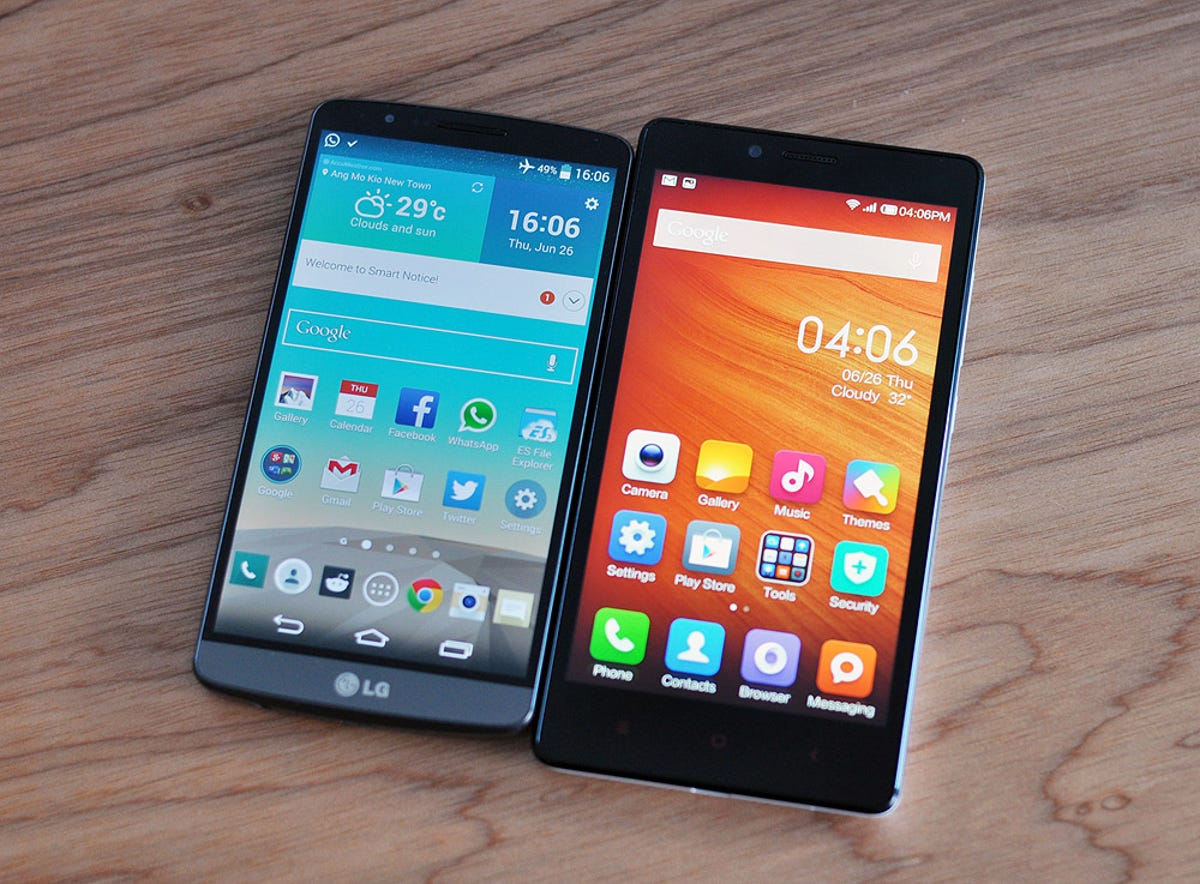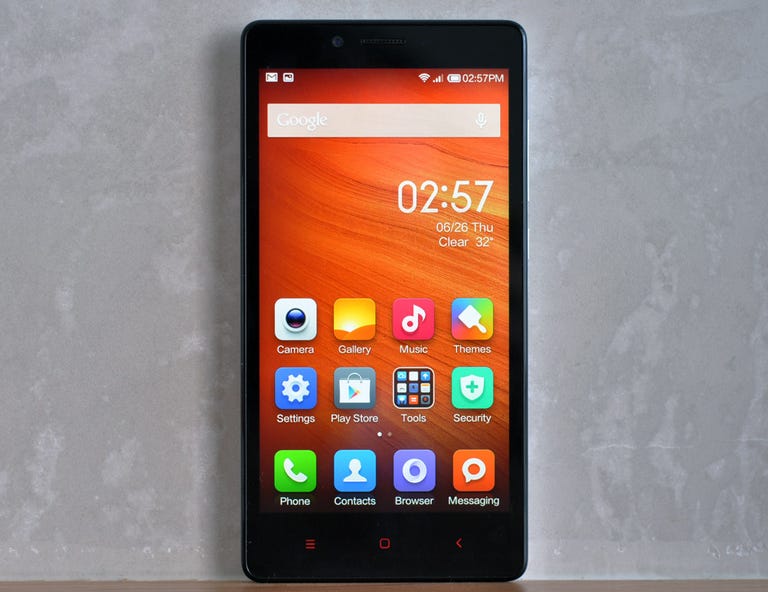 Why You Can Trust CNET
Why You Can Trust CNET Xiaomi Redmi Note review: Big, bold, and cheap to boot
Xiaomi's 5.5-inch Note may lack the latest hardware, but blends affordability with just the right performance.
Xiaomi's Redmi Note isn't a new flagship phone from the Chinese company. Rather it's an affordable dual-SIM device powered by MediaTek's octa-core processor that's under $160, £95, or AU$170.
The Good
The Bad
The Bottom Line
While you'd expect Xiaomi would have had to make a bunch of compromises to hit such a low price, the Redmi Note is surprisingly packed full of useful features, including a 13-megapixel camera and a 5.5-inch IPS 720p display. The only thing lacking is it still runs Android 4.2.2 Jelly Bean, but the custom MIUI skin does a good job of helping to hide the fact.
The Redmi Note is currently only available in Asia (China, Hong Kong, Malaysia, Singapore, and Taiwan) but you can get it online from third-party retailers. It will cost HKD$1,239 ($159) in Hong Kong, RM509 ($157) in Malaysia, and S$199 ($154) in Singapore. Those prices convert to around £95 or AU$170.
Design
Resembling a super-size version of the Redmi , the Note is pretty hefty. Its 5.5-inch screen has a lot of plastic around it, and that makes it heavy: 7 ounces (199 grams). While the weight does give a solidity to the phone, it can feel a tad too big when placed next to the smaller LG G3 , which has a similar screen size.

But that's quite an unfair comparison, to be honest. The G3 is a top-of-the-line device engineered to be ridiculously small (for its screen size), while the Note is much cheaper, aimed at a less demanding market. That said, it's not like Xiaomi hasn't paid any attention to how the Note was designed.
Clad in glossy white plastic, the phone feels just like any other plastic phone on the market. The choice of color is a good one, as it helps to hide the inevitable fingerprint smudges you'd expect from glossy surfaces. As the cover is removable, you can swap it out for other designs if that's your preference, but those are only available in China for now.
The phone has rounded corners, which sit well in the palm. If you're using this phone to play games in a landscape orientation, you'll find it pretty comfortable to grip. One thing though: the glossy plastic back does feel slick after some use, due to residue left by fingerprints.
Also found at the back of the phone is a 13-megapixel camera that boasts a 28mm wide-angle lens with LED flash. The front shooter packs 5 megapixels.
Internally, the Note is powered by a 3,200mAh battery and runs off a MediaTek MT6592 octa-core processor clocked at 1.7GHz. There are two versions of the phone: the other uses the same chip but clocked at 1.4GHz and only has 1GB RAM. The 1.7GHz version, which this review is based on, comes with 2GB.
Onboard storage is limited to a mere 8GB but the phone has a microSD card slot for another 32GB of space. Lastly, there's no 4G connectivity, but the phone supports 3G connectivity, Wi-Fi, and Bluetooth 4.0.
Software and features
Like all Xiaomi handsets, the Note comes with MIUI, which is Xiaomi's take on the Android operating system -- in this case, Android 4.2.2 and not the latest, 4.4 KitKat. One of the included features is drawerless home screens similar to iOS. This means all apps appear right on the home screen.
Other features include themes and Lite Mode, which makes its reappearance here -- it was left out on the Xiaomi Mi 3 . Lite Mode's supersize icons makes the phone much easier to use for people with visual impairments or who aren't too tech-savvy. If you have an elderly relative who has poor eyesight, the Note, with its large 5.5-inch display and Lite Mode, could be perfect.
I've written quite a bit about MIUI in the Xiaomi Mi 3 and Redmi reviews, and there's basically no change to the UI here. So instead of repeating everything, I'll pick out the one feature I really like about it.
The ability to quickly move apps from screen to screen simply by tapping and holding an app, then using another finger to swipe and change the current page, is really helpful. It's intuitive and easy, and makes me wonder why other manufacturers haven't implemented something similar. On most phones you have to drag an app to the edge of the screen to change the page, which is fiddly and takes longer.
Camera
Given how little the phone costs, you'd expect Xiaomi to have settled for cheap, low-megapixel cameras, but that's not the case here. While it doesn't have built-in optical image stabilization, the rear 13-megapixel camera is as fast as those in most high-end phones. Do note, however, that the camera lacks a backside-illuminated sensor, so low-light shots won't give results as good as you'd get from the higher-end flagship smartphones.
As for the image quality, I found pictures to have plenty of detail. I particularly liked the macro shots, which had a pleasing-looking depth of field. Like the Mi 3's camera, the Note's keeps it simple without any special tricks, but comes with the standard slew of filters, panorama mode, and HDR.
Performance
Like the Huawei Honor 3X , the Note comes packing a "true" eight-core processor. Unlike Samsung's Exynos octa-core processors, which have a "4+4" configuration in which slower cores take over to save power when heavy processing isn't required, the MediaTek MT6592 uses all eight cores at the same time.
Xiaomi's MIUI is pretty well optimised, and I didn't encounter any sluggishness with the phone like I did with the Honor 3X. On the Quadrant test, the phone scored 16,836, which isn't too far behind this year's flagship phones, which typically score in the 21,000-to-23,000 range. On Linpack, the Note achieved 287.8MFLOPs over 0.59 seconds, which is similar to the performance of the midrange LG Optimus L90 , which is powered by a quad-core Qualcomm Snapdragon 400 processor.
Call quality
I had no problems making phone calls. Sound was crisp and clear, very similar to what I encountered with the Xiaomi Mi 3. The Note's speaker volume was also sufficiently loud, though the speaker is located at the rear, which means you may need to use your cupped hand to bounce the sound to your ears in noisy environments.
Battery life
Loaded with a removable 3,200mAh battery, the Redmi Note should easily last you a full day and beyond. I'm still testing the battery life of the phone, so check back for an update pretty soon. There are also power settings that let you configure performance to maximise your battery life.
Conclusion
While you won't be able to easily get your hands on the Xiaomi Redmi Note outside of its launch countries, some third-party online retailers stock the phone at a premium and ship worldwide. That's at the risk of not having a warranty, however, and should the phone break down, it will be hard to get it serviced.
As always, Xiaomi has packed plenty of value into the phone, and the Note easily beats its competitors hands-down on that score. While it doesn't have 4G, compared with the non-LTE version of the Moto G , which retails at $179 or around £100 or AU$240, the Note seems like a much better deal.
Xiaomi's Redmi Note is likely to be a hit with business travellers as well as folks who want to try out a good Android phablet without having to pay a premium. You'd be well served by this phone.


